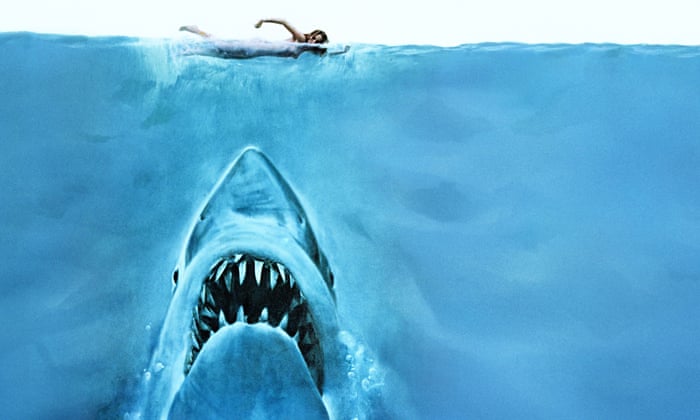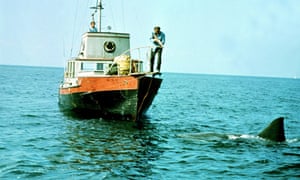
The classic poster image from the first release of the film Jaws. Photograph: Allstar/UNIVERSAL/Sportsphoto Ltd./Allstar
In 1975, the film ‘Jaws’ was released, directed by Steven Spielberg. Based on Peter Benchley’s 1974 novel about a relentless man-eating great white shark that terrorised a fictional American resort town. The film was a domestic and worldwide success, in 78 days it overtook The Godfather as the highest-grossing film in North America at box office, and has made over $470 million in global returns. The success of the original also led to three sequels being released.
The importance of Jaws is that it shaped the worldwide views of so many people about sharks, and how they perceive the dangers of the ocean. It’s influence on people’s views about sharks were caused by most knowing very little about the species beforehand and appealing to one of humanities strongest emotions – fear. The film apparently had movie-goers paralysed with fear.

‘We’re gonna need a bigger boat’ … Richard Dreyfuss and Robert Shaw in a scene from Jaws. Photograph: Everett/REX_Shutterstock
A leitmotif composed by John Williams, was used to associate with Jaws throughout the film before a presumed attack. The music used is a two-note motif of an alternating minor second interval, and it meets Hickman’s (2006) requirements for a leitmotif – ‘one must observe a clear and consistent relationship between a musical idea and its onscreen counterpart’. The leitmotif is used successfully to ensure the audience know that Jaws is a relentless killer that can terrorise anyone in its waters, which is clearly demonstrated in this scene.

‘The ocean’s most feared apex predator, the Great White Shark (Carcharodon carcharias)’ Photography by: Karen Schofield
Subsequently, the success of the film in demonising sharks as relentless killers have led to a devastating influence on shark populations since the film’s release. “Thousands of fishers set out to catch trophy sharks after seeing Jaws,” says George Burgess, director of the Florida Program for Shark Research in Gainesville. For many at this time sharks were viewed as an evil as a result of their portrayal in Jaws, this led many thinking that they were doing a good deed by removing the perceived monsters from their local beach. Research by the biologist Dr Julia Baum found that between 1986 and 2000, in the Northwest Atlantic Ocean, there was a population decline of 89% in hammerhead sharks, 79% in great white sharks and 65% in tiger sharks – a devastating consequence.

The tragic irony is that humans are the relentless monsters of the seas not sharks, the scale of that can be clearly seen in the image above.

A close encounter during a cage shark diving experience. Credit: Andrew Fox
However, the film was also responsible for a flood of scientific interest and expansions in conservation groups globally. “Knowing what I know now, I could never write that book today” said Peter Benchley, the author of Jaws. He spent a large portion of his life helping to conserve sharks and to educate the public about them. It is clear that to protect this vital keystone species of marine environments we must continue to further increase public knowledge about the species through tourism and public education, and to enforce appropriate fishing regulations and to utilise appropriate shark hazard policy.